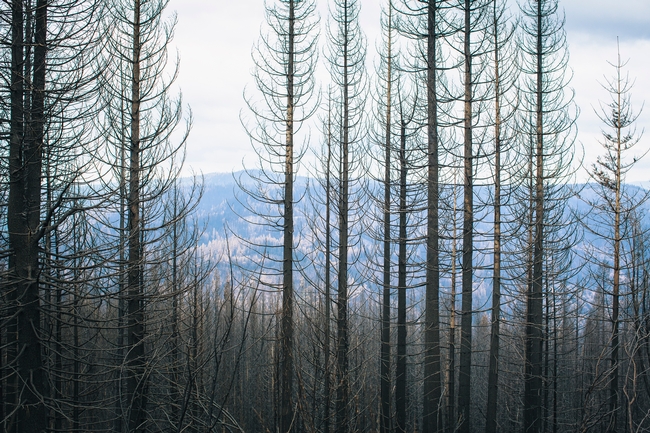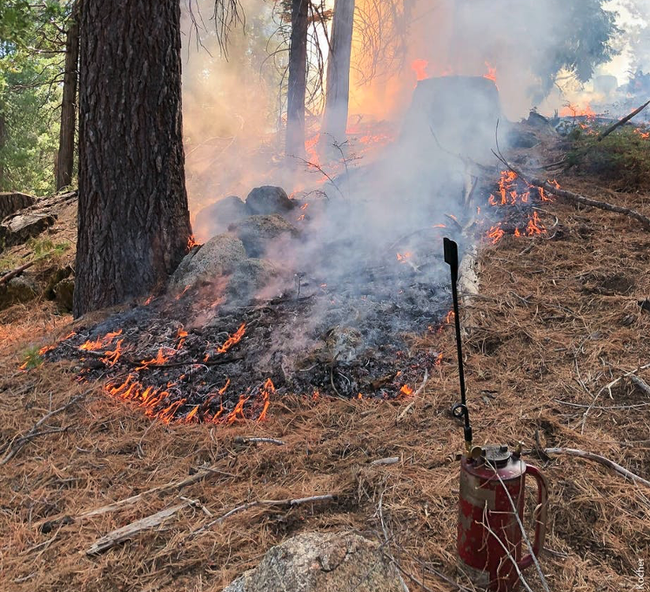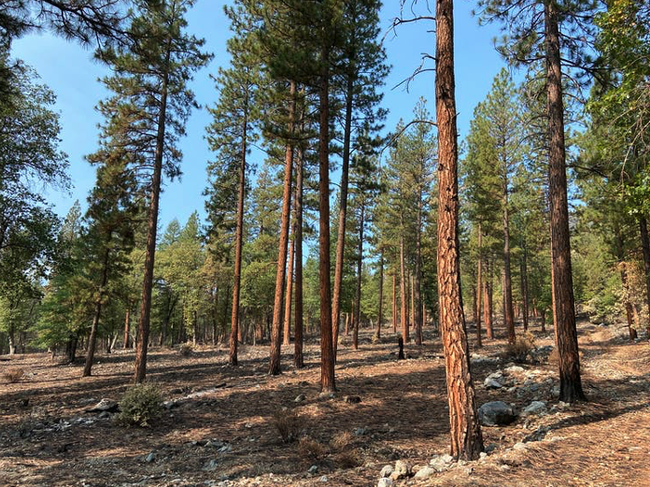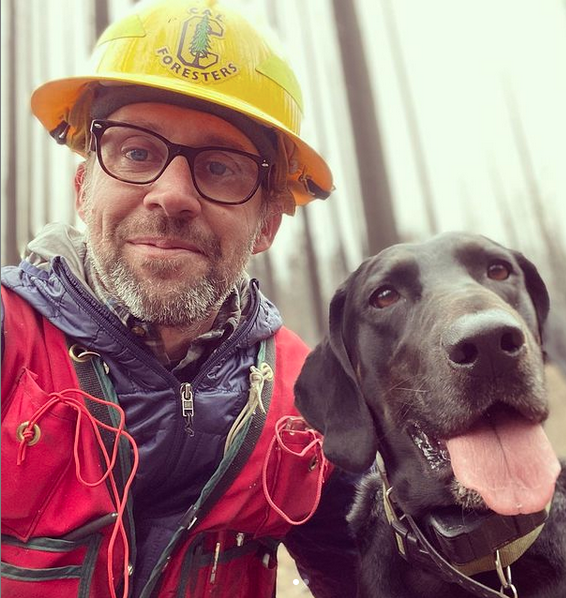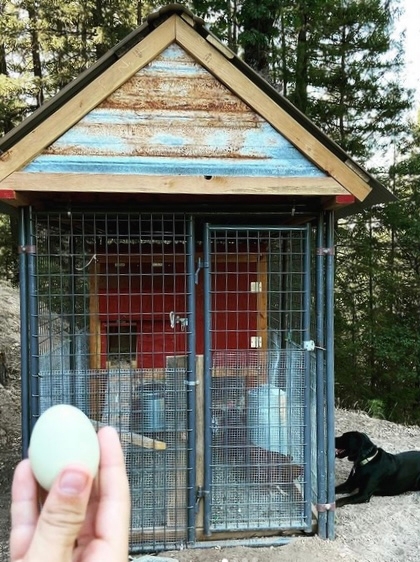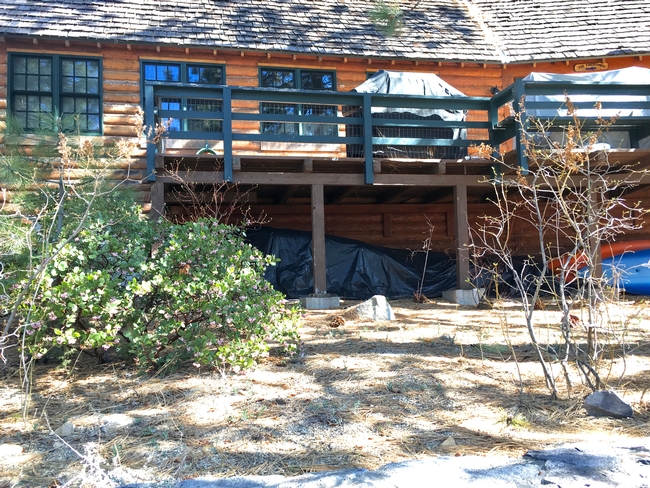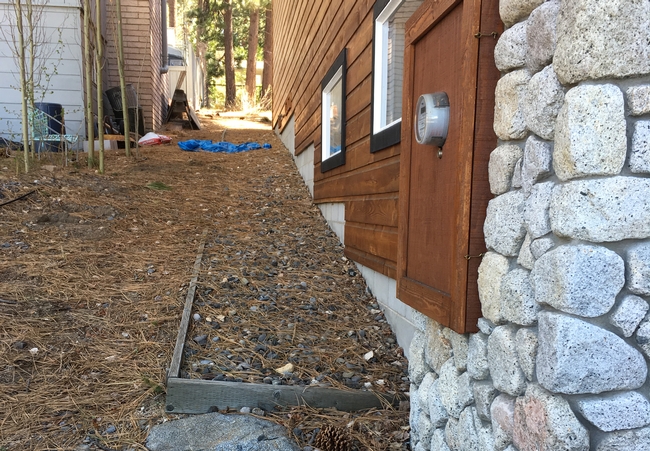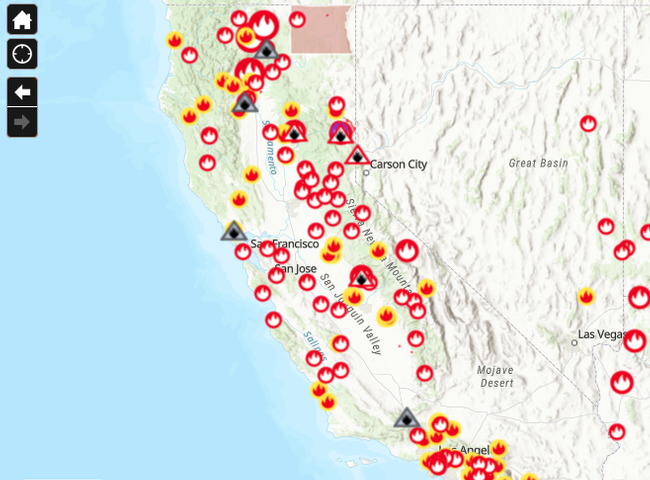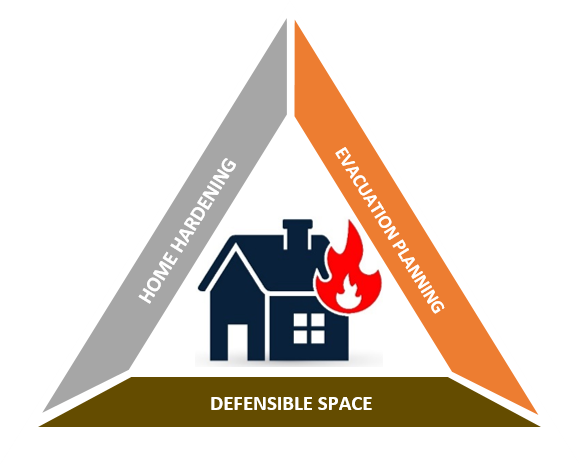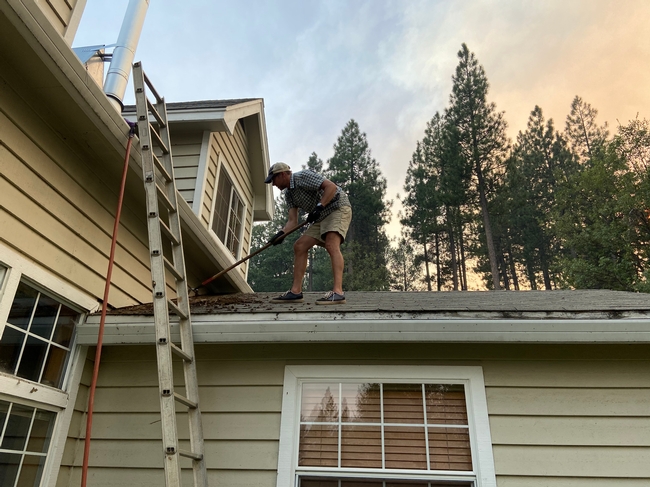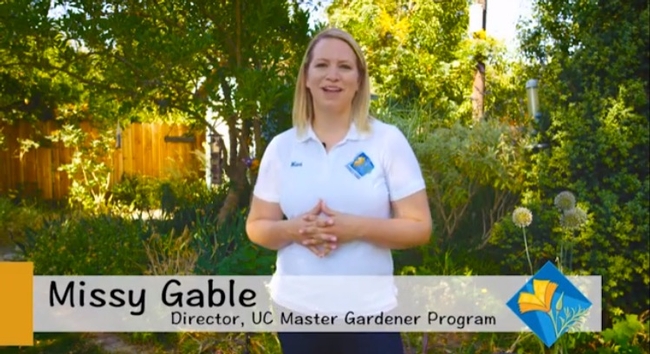Posts Tagged: Ryan Tompkins
Just what is a ‘resilient’ forest, anyway?
Study finds resilient, frequent-fire forests have far fewer trees
What does a “resilient” forest look like in California's Sierra Nevada? A lot fewer trees than we're used to, according to a study of frequent-fire forests from the University of California, Davis.
More than a century ago, Sierra Nevada forests faced almost no competition from neighboring trees for resources. The tree densities of the late 1800s would astonish most Californians today. Because of fire suppression, trees in current forests live alongside six to seven times as many trees as their ancestors did — competing for less water amid drier and hotter conditions.
The study, published in the journal Forest Ecology and Management, suggests that low-density stands that largely eliminate tree competition are key to creating forests resilient to the multiple stressors of severe wildfire, drought, bark beetles and climate change.
This approach would be a significant departure from current management strategies, which use competition among trees to direct forest development.
Defining ‘resilience'
But first, the study asks: Just what does “resilience” even mean? Increasingly appearing in management plans, the term has been vague and difficult to quantify. The authors developed this working definition: “Resilience is a measure of the forest's adaptability to a range of stresses and reflects the functional integrity of the ecosystem.”
They also found that a common forestry tool — the Stand Density Index, or SDI — is effective for assessing a forest's resilience.
“Resilient forests respond to a range of stressors, not just one,” said lead author Malcolm North, an affiliate professor of forest ecology with the UC Davis Department of Plant Sciences and a research ecologist with the U.S. Forest Service, Pacific Southwest Research Station. “‘Resistance' is about surviving a particular stress, like fire — but there's a lot more going on in these forests, particularly with the strain of climate change.”
Competitive nature
For fire-adapted forests in the Sierra, managing for resilience requires drastically reducing densities — as much as 80% of trees, in some cases.
“Treatments for restoring resilience in today's forests will need to be much more intensive then the current focus on fuels reduction,” said Scott Stephens of UC Berkeley, a co-author on the paper.
The study compared large-scale historical and contemporary datasets and forest conditions in the southern and central Sierra Nevada, from Sequoia National Forest to the Stanislaus National Forest. It found that between 1911 and 2011, tree densities increased six- to seven-fold while average tree size was reduced by half.
A century ago, both stand densities and competition were low. More than three-quarters of forest stands had low or no competition to slow a tree's growth and reduce its vigor. In contrast, nearly all — 82%-95% — of modern frequent-fire forests are considered in “full competition.”
The study indicates that forests with very low tree densities can be more resilient to compounded threats of fire, drought and other climate stressors while maintaining healthy water quality, wildlife habitat and other natural benefits. Forests burned by high-severity fires or killed by drought lose such ecosystem services.
Wake-up call
The authors say the 2012-2016 drought, in which nearly 150 million trees died from drought-induced bark beetle infestations, served as a wake-up call to the forestry community that different approaches are required to help forests confront multiple threats, not only severe wildfires.
A shift away from managing for competitive forests and toward eliminating competition could allow the few to thrive and be more resilient.
“People have grown accustomed to the high-density forest we live in,” North said. “Most people would be surprised to see what these forests once looked like when frequent surface fires kept them at very low densities. But taking out smaller trees and leaving trees able to get through fire and drought leaves a pretty impressive forest. It does mean creating very open conditions with little inter-tree competition. But there's a lot of historical data that supports this.”
“We think resilient forests can be created, but it requires drastically reducing tree density until there's little to no competition,” said Brandon Collins of UC Berkeley, another co-author on the paper. “Doing this will allow these forests to adapt to future climate.”
Additional co-authors include Ryan Tompkins of UC Cooperative Extension, and Alexis Bernal and Robert York of UC Berkeley.
The study was funded by the National Park Service Pacific West Region, U.S. Forest Service Pacific Southwest Research Station, U.S. Joint Fire Sciences Program, and the UC Agriculture and Natural Resources Division.
Moving beyond America’s war on wildfire: 4 ways to avoid future megafires
Californians have been concerned about wildfires for a long time, but the past two years have left many of them fearful and questioning whether any solutions to the fire crisis truly exist.
The Dixie Fire in the Sierra Nevada burned nearly 1 million acres in 2021, including almost the entire community of Greenville. Then strong winds near Lake Tahoe sent the Caldor Fire racing through the community of Grizzly Flats and to the edges of urban neighborhoods, forcing the evacuation of tens of thousands of people – including one of us. Those were only the biggest of the 2021 fires, and the risk isn't over. A wind-blown fire that started Oct. 11 was spreading quickly near Santa Barbara on the Southern California coast.
As foresters who have been working on wildfire and forest restoration issues in the Sierra Nevada for over a quarter of a century, we have found it painful to watch communities destroyed and forests continuing to burn to a crisp.
The main lesson we gather from how these fires have burned is that forest fuels reduction projects are our best tools for mitigating wildfire impacts under a changing climate, and not nearly enough of them are being done.
Two historic policies, in our view, led the western U.S. to the point where its forests have become so overgrown they're fueling megafires that burn down whole communities.
Fire suppression
The first policy problem is fire suppression and exclusion.
Fire is an essential ecological process, and many of the ecosystems in the West are adapted to frequent fire, meaning plant and wildlife species have evolved to survive or even thrive after wildfires. But most people arriving in California during colonization, both before and after the Gold Rush of 1849, fundamentally misunderstood the nature of frequent fire forests.
As state and federal agencies evolved policies on forest management, they considered all fire to be an existential problem and declared war. The U.S. Forest Service kicked off a century of fire suppression in the West after the devastating fires of 1910, known as the “Big Blowup” or “Big Burn,” by implementing the 10 a.m. policy. It aimed for full suppression of all fires by 10 a.m. the day after they broke out.
Native people who practiced prescribed fire to manage forests were removed from their homelands, and burning was criminalized. California made prescribed fire illegal in 1924, and it remained illegal for decades until a better appreciation of its importance emerged in the 1970s.
Past harvesting practices lead to regulations
The second policy issue is the regulatory approach that grew out of past logging practices.
Foresters and early California communities were interested in forests for lumber and fuel wood. They sent the largest – and most fire-tolerant – trees to mills to be turned into lumber, which was used to build California's cities and towns.
Poorly executed logging in some areas led to concerns from residents that forest cover and habitat was shrinking. As a result, state and federal regulations were developed in the 1970s that require managers proposing forest projects to consider a “no action alternative.” In other words, maintaining dense forest habitat in the long term was considered a viable management choice.
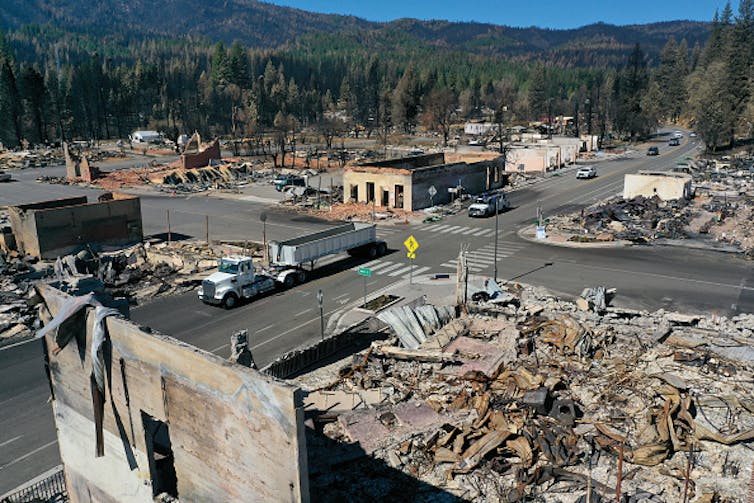
On private land, few owners today thin the forest to levels that would mimic the more fire-resilient forests found in the Sierra at colonization. The California Forest Practices Act until recently required replanting after timber harvest to levels much more dense than were found at colonization. In other words, our current regulatory framework promotes maintaining high levels of forest density, when much more drastic removal of vegetation is needed.
Taken together, these policies have promoted 21st-century forests that are younger, denser and more homogenous – making them vulnerable to increasingly severe disturbances such as drought, insect outbreaks and fire. This new reality is exacerbated by a changing climate, which turns the regulatory assumption that active and widespread forest management is riskier than no management on its head.
Agency priorities change as the crisis grows
Just as forests have changed, so too have the agencies that manage and regulate them. The U.S. Forest Service has seen its budgets for fighting fires balloon while its capacity to proactively manage forests has been shrinking. The California Department of Forestry and Fire Protection, known as CAL FIRE, has also seen large increases in firefighting budgets, though the state legislature has recently moved to increase fire prevention funds, too.
Living in communities threatened by wildfires this summer, we are very grateful to firefighters who have saved our homes. Yet we also are concerned that more large, high-severity wildfires burning across the landscape mean less funding and staff will be available for proactive fuels reduction projects like forest thinning and prescribed fires.

How do we get out of this mess?
The Dixie and Caldor fires that destroyed Greenville and Grizzly Flats provided evidence that forest fuels reduction projects can work.
Both fires burned less severely in areas with proactive forest restoration and fuels management projects, including near South Lake Tahoe and near Quincy.
Fuels reduction projects include thinning out trees, burning off woody debris and reducing “ladder fuels” like small trees and brush that can allow fire to reach the tree canopy. They create more open forests that are less likely to fuel severe megafires. They also create strategic areas where firefighters can more easily fight future blazes. And, because fires burn less intensely in thinned forests, they leave more intact forest after a fire for regenerating new trees and sequestering carbon. Prescribed fires and managed ignitions paid huge dividends for containing the Dixie and Caldor fires.
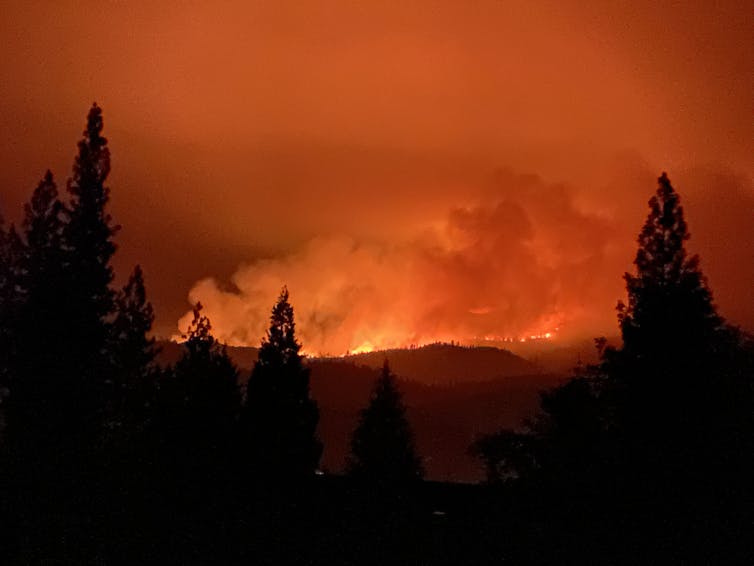
To manage fires in an era of climate change, where drier, hotter weather creates ideal conditions for burning, experts estimate that the area treated for fuels reduction needs to increase by at least an order of magnitude. We believe government needs to accomplish these four things to succeed:
1) Drastically increase funding and staff for agencies' fuels reduction projects, as well as outreach, cost-sharing and technical assistance for private forestland owners. Although the Biden administration's proposal for a Civilian Climate Corps proposes funding to bring in more young and unskilled workers, funding more federal and state agency positions would recruit more natural resource professionals, provide career-track opportunities and better add forest restoration capacity for the long term.
2) Reduce regulations on forest and fuels management efforts for both public and private land. While California and the federal government have made recent strides to streamline regulations, land management agencies need to acknowledge the biggest risk in frequent fire forests is doing nothing, and time is running out. Agencies need to drastically cut the time needed to plan and implement fuels reduction projects.
3) Invest in communities' capacity to carry out local forest restoration work by providing long-term support to local organizations that provide outreach, technical assistance and project coordination services. Funding restoration through competitive grants makes development of long-term community capacity challenging at best.
4) Provide funds and financial incentives for at risk communities to retrofit homes to withstand wildfires and reduce fuels around homes, communities and infrastructure.
Under a changing climate, we will have to learn to coexist with wildfires in the U.S. West, but this will require concerted action and a cultural shift in how we view and manage our forests and communities to be resilient.
Susan Kocher, Cooperative Extension Forester and Natural Resources Advisor, University of California, Division of Agriculture and Natural Resources and Ryan E. Tompkins, Cooperative Extension Forester and Natural Resources Advisor, University of California, Division of Agriculture and Natural Resources
This article is republished from The Conversation under a Creative Commons license. Read the original article.
Small steps can help homes survive wildfire
As the Beckwourth Complex Fire and Dixie Fire spread in Plumas and Lassen counties, Ryan Tompkins reminded residents of ways they could help limit damage.
“If you're under evacuation orders, abide by the evacuation notice, because lingering too long can complicate tactics of emergency responders,” said the University of California Cooperative Extension forestry and natural resources advisor, who recommends packing up important documents and valuables with an overnight bag in advance for a quick exit to safety.
Plan for pets and livestock and water access for a quick response to falling embers that ignite fires. The Plumas County resident said he packed a “go bag” for his dog filled with dog food and other necessities. Every year, Tompkins clears defensible space around his house, including defensible space around his chicken coop in case a fire starts while he isn't home. During wildfire season, he keeps a shovel and a backpack sprayer filled with water staged near his woodshed for easy retrieval if a fire were to start in his yard. If Tompkins needs to evacuate, he switches his circuit box to his generator so any firefighters performing structure triage can access his well water when the power grid shuts down.
To document possessions for insurance purposes if the house burns, Tompkins recommends shooting video. “Just walk through the house with your phone shooting video and narrating to document the household assets.”
Residents outside of the wildfire evacuation area can take more steps to improve the odds their homes will survive a wildfire.
Even with fire imminent, there are several actions you can do to help prepare your home to withstand fire exposure. UC Cooperative Extension guidance can help residents prepare their home in the days or hours before wildfire exposure.
If you believe you have at least a couple of hours before fire exposure, review the area around your home and outbuildings for flammable items that could lead fire to the structures, said Yana Valachovic, UC Cooperative Extension forestry advisor in Humboldt and Del Norte counties.
She recommends the following:
- Move combustible items inside or away from the buildings, especially within the first 5 feet of any structure or attached deck
- Clean gutters and other places where pine needles and leaves accumulate on or near the house
- Move BBQ propane tanks away from structures
- Bring in cushions from outside furniture
- Move doormats away from the house
- Seal vents (attic, foundation, drier, etc.) with plywood or heavy foil to prevent embers from entering
- Close all windows and pet doors
“The goal is to remove combustible items away from structures so that embers don't ignite these materials and result in flames touching the house,” Valachovic said. “Temporarily sealing up vents can help prevent embers, or small bits of burning vegetation, from being blown inside the home.”
If first responders get to your home, Valachovic says you can help them by leaving a ladder against the house, placing buckets or garbage cans of water around the home, and leaving connected garden hoses in easy-to-locate places. Also, leave out a shovel or other tool that could be used to put out small spot fires.
“After you have packed your essentials and your go bag, dress for the evacuation by wearing cotton or wool clothing, a hat, boots, bandanna or mask to protect your nose and mouth, and pack leather gloves,” she said. “These items will help you be prepared if you have to get out of your vehicle or move fallen trees during your escape to safety. Additionally, it may be helpful to pack a shovel, digging bar, chainsaw, or other tools just in case your evacuation route gets blocked.”
As you evacuate, Valachovic suggests leaving gates open or unlocked so first responders can access your property.
If time allows, turn on the lights in your house to increase visibility and leave a note on the door indicating where you went and who is with you. These instructions can help you reunite with your loved ones.
Thinking through these steps and implementing them if fire is near can help your home and your family survive wildfire. For more evacuation guidance, visit https://ucanr.edu/sites/fire/Safety/Evacuation.
If you have more time to prepare for wildfires, UC Cooperative Extension provides more information at https://ucanr.edu/sites/fire/Prepare, including a fire map and tips for home hardening and defensible space strategies.
How to Harden Homes against Wildfire, a free 20-page publication by University of Nevada, Reno Extension, UC Cooperative Extension, Tahoe Resource Conservation District and CAL FIRE is also available online at http://ucanr.edu/HomeRetrofitGuide. It includes recommendations for 12 vulnerable components of homes in wildfire-prone areas, including roofs, gutters, vents, siding, windows, decks and fences.
May is Wildfire Preparedness Month!
Many of us know May for flowers and Mother's Day (hope you didn't forget!), but after last year's widespread and long-lasting fire season, many Californians have come to recognize May as Wildfire Preparedness Month. Our lackluster winter in Northern California underscores the necessity for wildfire preparedness as we embark on our seasonal drought typical of Mediterranean climate summers. Just as many in the mountainous West prepare for winter storms by squirreling away firewood, cleaning rain gutters, and taking down the patio furniture, we also must prepare for summer wildfires in analogous ways: clearing dead leaves and debris from our homes, removing the firewood from the deck, and yes, cleaning those gutters again!
Much of wildfire preparedness centers on residents taking personal responsibility to prepare, and it's the a
ccretion of homeowners' personal responsibility that contributes to greater community preparedness. Homeowners can think of their personal wildfire preparedness actions in three simple categories:- Creating and maintaining defensible space around your home,
- Improving your home's resistance to ignition (a.k.a. “home hardening”)
- Household evacuation planning and preparation.
Wildlife preparedness survey results preview
At the beginning of the 2020 fire season, we asked residents in five northeastern California counties about efforts they were taking to prepare for wildfires and what barriers they perceived in reaching their goals.
- Nearly all indicated that wildfire had impacted their community within the past decade.
- Almost half of the residents indicated their home insurance had been affected in some way (e.g. insurance rate increase, dropped policy) by wildfire risk.
- Most residents were creating and maintaining defensible space on their property by doing the work themselves or paying for it out of their own pocket – very little was grant funded.
- Many homes in rural communities are older, built long before 2008 WUI (wildland urban interface) building standards were put in place. These homes are in need of retrofitting and there is a growing number of residents interested in home hardening.
- There is high participation in community emergency notification systems (e.g. Code Red, Everbridge), but only a minority of residents have an evacuation plan or taken steps to prepare for evacuation. Rural communities, understandably, have a large populations of domestic pets and livestock that require evacuation planning!
While rural northeastern California communities are engaging in wildfire preparedness, time, cost, technical knowledge, and physical capacity were all barriers to creating defensible space and home hardening. So the question becomes, what can we do to increase and enhance our community effectiveness in terms of wildfire preparation?
Get involved and get organized
One of the best places to start is engaging with your community on education and outreach. There are a number of organizations that support this mission, some of the most prolific in California include Fire Safe Councils, Firewise USA® Sites, and Fire Adapted Communities. Fire Safe Councils are local and countywide organizations of interested community members, land management agencies/organizations (e.g. Forest Service), and natural resource and fire management professionals (e.g., volunteer fire district) who are interested in coordinating community-level fuel reduction treatment, education and outreach. You can find more details about local and countywide fire safe councils at the California Fire Safe Council.
Firewise USA® Sites is a nationwide program supported by the National Fire Protection Association (NFPA) designed to empower local neighborhoods and communities to think and act strategically regarding wildfire preparedness. The NFPA Firewise USA® Site program shepherds communities through a process to develop a community wildfire risk assessment, create a community specific action plan of activities to improve wildfire awareness and preparedness, and document the actions community members are taking to mitigate risk.
Fire Adapted Communities and the Fire Adapted community Learning Network provides another context for how all these organizations contribute to wildfire preparedness and offer a forum to connect with communities across the nation that are endeavoring to achieve the same goals: communities that can coexist and be resilient to fire.
Take responsibility and be strategic
The uncertainty in wildfire can be frightening and the task of preparing for wildfire can be overwhelming, but we can all take responsibility and take strategic action – and the accretion of our efforts, and our neighbors' efforts, can contribute to community resistance to wildfire. As the saying goes, Rome was not built in a day. For those of us who have been evacuated or worse, there are always preparedness actions we wished we could have taken sooner or those things that we find ourselves doing at the last minute. May wildfire preparedness month gives us an opportunity before fire season heats up to walk around our yard and home to think about what we'd like to do to prepare. CALFIRE's Ready, Set, Go program has great materials and lists of things to think about.
May also brings great weather to work out in the yard (defensible space) and work on the house (home hardening)! The UCANR Fire in California website has helpful science-based information for homeowners on defensible space, reducing fuels, fire-safe landscaping, and how to prepare your home to be resistant to wildfire. Walk around your home and yard and look at where all your leaves accumulate….those eddies might be the same area an ember might land: Would it burn anything? Pick a project or two that you think is affordable and attainable and make it happen. Very few of us have the money or time to improve everything in a month, but doing what we can still moves the needle on preparedness.
Don't wait to think about evacuation!
Similarly, our UC Cooperative Extension needs assessments and surveys help inform what people are doing, where barriers exist, and easy places to start. Residents responding to surveys help make this happen and these data help the aforementioned partners design relevant programs to help homeowners. For example, we know from our needs assessment that while many people are signed up with an emergency notification system, only a minority have evacuation go-bags, family evacuation/rendezvous plans, important documents, or home inventories in place.
May is a good time to start having those conversations with your family, friends and neighbors. Talk to your family and your kids about what to do if there's a fire when only a portion of the family is at home: Where would you meet? Who would you call? Do you have any neighbors that might need help? What about all those dogs, chickens and horses? Take an evening in May and organize your important documents or make a video inventory of the belongings in your home for insurance documentation. It is best to plan now and plan for an early evacuation during fires!
UC Cooperative Extension advisors and community education specialists across California are committed to fire resiliency and community disaster preparedness. This blog provides a snapshot of the community-based research we conducted last year. UCCE is also working on promoting grazing as a tool to reduce catastrophic fires, reintroducing prescribed fire to reduce fire fuel loads, researching building materials and designs for home survival in wildfire-fire prone areas and much more. Please join us in creating a fire-resilient community by taking actions this May for fire preparedness around your home and creating an evacuation plan with your family.
If you have questions, need help or are looking for technical advisor, please reach out to your local University of California Cooperative Extension office.
ANR in the news April 1-15, 2020
Pandemic And Wildfire: California Is Preparing For A Crisis Within A Crisis
(CapRadio) Ezra David Romero, April 15
…To protect human health, prescribed burns are not allowed for the time being on Forest Service land. But Ryan Tompkins, a forest advisor with the UC Cooperative Extension for Plumas, Sierra, and Lassen counties, says it's still early enough to prepare for wildfire with other tools like thinning and in some cases burning.
“It is really difficult because of the concerns about smoke and COVID, but sort of now is our chance to be prepared,” said Tompkins.
…“We know the agencies are going to have maybe limited capacity, limited resources, they're going to have other strains on their organizations while dealing with this crisis,” Tompkins said. “So, I think it emphasizes in a silver lining way that we all have a piece to play or a role to play.”
Susie Kocher, a forest adviser for the Lake Tahoe region with the UC Cooperative Extension, is concerned about a triple threat of COVID-19, wildfires, and power shutoffs.
“These two potential situations just could stack on top of the uncertainty of what people need to do,” she said.
Pandemic Crisis Got You Planting a Garden? Join the Club. (18:23)
(BYU Radio) April 14
Guest: Rose Hayden-Smith, PhD, Kellogg Food and Society Policy Fellow, Emeritus Professor of Agriculture and Natural Resources for the University of California, Author of "Sowing the Seeds of Victory: American Gardening Programs of WWI"
The pandemic has sparked a moment of “crisis gardening” among Americans. It's not much different from the Victory Gardens that sprung up in yards around the country during World War I, and then again in World War II.
New fungicide approved for Calif. tree nuts
(Farm Press) Tim Hearden, April 14
… University of California, Riverside plant pathologist Jim Adaskaveg helped develop data to validate the efficacy of ManKocide for California tree nuts and says the product has advantages, including ease of use.
It is also highly effective against copper-resistant bacteria in California, Adaskaveg said in an email.
“The product has efficacy against the walnut blight and bacterial spot of almond pathogens and suppresses fire blight on pome fruit and bacterial blast on almond,” he said.
Adaskaveg said he is unaware of other products that have this combination as a premixture,
https://www.farmprogress.com/tree-nuts/new-fungicide-approved-calif-tree-nuts
People are rushing to plant 'pandemic gardens' and seed companies say they can't keep up with the surge in demand
(Business Insider) Michelle Mark, April 14, 2020
…It's not the first time economic crises have led Americans to grow their own food. One food historian told HuffPost that the trend began during WWI and WWII.
"Crisis-gardening is not new," Rose Hayden-Smith, the author of "Sowing the Seeds of Victory," told the outlet.
https://www.insider.com/seed-companies-cant-keep-up-with-demand-for-pandemic-gardens-2020-4
4-H searches for locals to serve on sponsoring committee
(San Benito Link) Devii Rao, April 14
We are looking for a few local people to serve on a sponsoring committee to keep 4-H active and strong in San Benito County. The sponsoring committee will organize events such as letter writing campaigns, barn dances, dinners, silent and live auctions, fireworks booths, having 4-H youth sell treats at the fair, or your other creative ideas! Sponsoring committee members are not required to have any affiliation with 4-H. We are looking for business leaders and other people who are well connected in the community and who are motivated to provide educational and leadership opportunities to our youth.
https://benitolink.com/4-h-searches-for-locals-to-serve-on-sponsoring-committee/
California dairies dump milk, crops may be left to wither as coronavirus pandemic disrupts food system
(SF Chronicle) Kurtis Alexander, April 12
…“Everybody's scrambling. The whole food system is scrambling,” said Daniel Sumner, an agricultural economist at UC Davis. “I don't see a big supply-side issue for agriculture. It's really an issue with the food (delivery) system.”
https://www.sfchronicle.com/news/article/California-dairies-dump-milk-crops-may-be-left-15195891.php
Widespread shutdown order slams California dairy farmers, ‘You can't turn off the cows'
(Sacramento Bee) Michael Finch II, April 10
…“Like every part of the food system, there are complications. The issue for milk is you can't turn off the cows,” said Daniel A. Sumner, an agricultural economist and professor at UC Davis. “What's becoming more of a problem is the slightly longer-term outlook where we have a massive recession (coming).”
Dairy prices are regulated by the federal government and fluctuate on the Chicago Mercantile Exchange. So the price of large quantities of milk, cheese, whey and milk powder is set based on data from the prior month, Sumner said.
In January, milk traded at nearly 18 cents per pound and by March the amount fell nearly five cents. Sumner said this suggests there is a price shock to come in the summer.
https://www.sacbee.com/news/california/article241896861.html
Grocers Serving Low-Income Neighborhoods Pinched by Shortages, Rising Prices
(KQED) Farida Jhabvala Romero, April 10
…“This hoarding behavior is unfortunate,” said Richard Sexton, a professor of agriculture and resource economics at UC Davis. “We can understand why people do it, but it is what's causing these disruptions.”
… The current shortages could deepen disadvantages for family-owned neighborhood stores, said Sexton, the UC Davis economist.
“The little guys, the small chains of just a few stores, could get the short end of the stick in this situation because food manufacturers and distributors are going to probably prioritize their biggest and best customers,” he said.
Private Grant Will Support New UC California Organic Institute
(Organic Farmer) Marni Katz, April 10
A $1 million endowment will establish the University of California's first institute for organic research and education within the UC's Agriculture and Natural Resources division (UC ANR), expanding the UC Cooperative Extension's research and outreach capacity to target organic growers in California.
http://organicfarmermag.com/2020/04/private-grant-will-support-new-uc-california-organic-institute/
UCANR points to help for Californians amid crisis
(Farm Press) Mark Bell, April 10
…In response to these pressing needs, UC Agriculture and Natural Resources, like many other universities and extension organizations across the country, are moving quickly to get more information online. While I haven't seen the actual numbers, we know millions of students (both high school and university) are quickly transitioning to online classes.
https://www.farmprogress.com/extension/ucanr-points-help-californians-amid-crisis
Scientists Worry Agency Plan to Prevent Fires Could Do Opposite
(Bloomberg) Bobby Magill, April 9
…Controlling wildfire in the region depends on how many firefighters the federal government has on the ground—and they'd have to be in the right place at the right time for the fuels reduction plan to work, said Max Moritz, a wildfire specialist at the University of California, Santa Barbara studying how wildfire affects broad landscapes.
As the climate changes, the effectiveness of fuels reductions projects and fuel breaks begins to fade, he said.
“Climate change seems to be priming the landscape for fires to ignite more easily, spread more easily, to burn hotter and larger—so all of these aspects of climate change would make one suspect that fuel breaks have a harder and harder time doing their job,” Moritz said.
The wildfire program is an “expensive large-scale experiment,” he said.
The real reason we're seeing more wildlife during the pandemic
(Pop Sci) Ula Chrobak, April 9
…In those cases, additional sightings might be due to simple behavior changes. But a less charismatic creature may be also on the rise due to an increased human presence at home. Niamh Quinn, a human-wildlife interactions advisor with the University of California, thinks that rat populations may be increasing in New Orleans and elsewhere. That's because people are cooking, storing, and disposing of at home, drawing rats away from closed restaurants and toward residences.
…Quinn agrees. Late last year, she radio-collared five coyotes in Los Angeles for a research project. She says that her coyotes haven't changed their routines since the shelter-in-place order went into effect, staying in their respective territories, which include areas near a shopping mall and golf course. Quinn adds that while the number of coyotes reported in San Francisco on the Coyote Cacher website isn't unusual, they could be moving about during the day more. “People are just at home noticing more things,” she says. “Especially in California, we're not all spending five hours a day on the freeway [now], you know?”
https://www.popsci.com/story/environment/wildlife-in-cities-covid-shutdown
HLB spreads slowly, confined to residential citrus
(Capital Press) Padma Naggapan, April 9
…”It's slower than we expected, compared to Texas and Florida,” said Elizabeth Grafton-Cardwell. “In the Central Valley, homeowners and growers have been able to eradicate the pest, although it's been much more challenging in Southern California. But growers are doing an outstanding job of controlling the psyllids.”
Almond Update: Maximizing Yields and Sustainability from Start to Finish
(AgNet West) Taylor Hillman, April 9, 2020
Setting an orchard up for maximum yield and sustainability is a long game for producers. There are lots of variables, and some are unpredictable such as mother nature. But UC Cooperative Extension Tree Crop Advisor Franz Niederholzer said growers can do several things in the life of an orchard to stay in the game. He believes the most sustainable plan in every aspect of growing is to not focus on hitting home runs but instead have constant attention on management to help them avoid making outs.
http://agnetwest.com/almond-update-maximizing-yields-and-sustainability-from-start-to-finish/
Soil health practices show benefits
(Morning Ag Clips) Jeannette Warnert, April 9, 2020
A group of California organic farmers is sharing information about their efforts to combine reduced tillage with the use of cover crops, which they have been planting on their vegetable farms for decades to protect soil while adding carbon and diversity to their production systems.
“Every one of the pioneering farmers has seen tremendous benefits from the practices,” said Jeff Mitchell, UC Cooperative Extension vegetable crops specialist. “These are the very growing practices that we have demonstrated over two decades of research to benefit soil health, environmental conservation and the bottom line on plots near Five Points in Fresno County.”
https://www.morningagclips.com/soil-health-practices-show-benefits/
Why are eggs getting so expensive? Blame coronavirus demand
(LA Times) Samantha Masunaga, April 8
…“Eggs are naturally, very often, one of the most price variable products in the supermarket,” said Daniel Sumner, UC Davis professor of agricultural economics and director of the UC Agricultural Issues Center.
…Egg prices could remain elevated for at least a few months, Sumner said. And the demand for eggs has been historically strong during tougher economic stretches. Eggs are a relatively cheap source of protein and aren't seen as a luxury food item.
“It may take longer to get back to normal for the egg business,” he said. “We can build supply, but it takes a few months.”
https://www.latimes.com/business/story/2020-04-08/egg-prices-rising-coronavirus
Rock Front Ranch permanently conserved for wildlife, grazing by Rangeland Trust
(Santa Maria Times) April 7
“To have this ranch be up against and abut to tens of thousands of acres of public lands is an indispensable connection to have in perpetuity,” said Matthew Shapero, livestock and range adviser in Santa Barbara and Ventura Counties for the University of California Cooperative Extension.
Nutrition experts fear 'dirty dozen' produce list will put off consumers
(UPI) Jessie Higgins, April 7
…"Our typical exposure to pesticides is far lower than levels of health concern," Carl Winter, an emeritus cooperative extension specialist in food and science technology at the University of California-Davis, said in an email.
"A graduate student and I published a paper in 2011 relating dietary exposure to toxicity for the 10 most frequently detected pesticides found on the EWG's 2010 Dirty Dozen list," he said. "Estimated exposures were far below levels of toxicological concern. Recommending consumers reduce their consumption of conventional fruits and vegetables on the Dirty Dozen list is unwarranted."
How to grow a vegetable garden, according to legendary chef Alice Waters
(Fast Company) Aimee Rawlins, April 7
… It's natural to want to go big and plant everything. But it's important to be realistic and start small, and not just because the productivity trap can be debilitating at a time like this.
“Right now we have enough on our plate. Start modestly and in a way that you can manage it,” says Missy Gable, director of the University of California's Master Gardener Program. “If you've never done this before, don't transform a quarter acre.”
… Because soil quality and composition varies depending on region and location, Gable recommends looking up your local master gardener extension program. These programs, which exist in all 50 states, offer classes and resources for home gardeners as well as knowledgable volunteers who are plugged in to local climate and soil particulars. Right now, some master gardener programs, like the one at Oregon State University, are also offering virtual classes. (OSU waived its fee for April and already has more than 17,000 participants.)
Pistachio Rootstock Options Today: Seedlings and Clones
(Pacific Nut Producer) Matthew Malcolm, April 6
Pistachio growers have more options today when it comes to varieties and rootstocks to plant with. Watch this brief interview with UCCE Farm Advisor Elizabeth Fichtner as she shares some of the characteristics of rootstocks currently available to growers and some of the pros and cons to planting on a seedling vs. clone. Read more in Pacific Nut Producer Magazine.
https://pacificnutproducer.com/2020/04/06/pistachio-rootstock-options-today-seedlings-and-clones/
UC urges cattle producers to take precautions
(Farm Press) Larry Forero, Sheila Barry, Josh Davy, Gabrielle Maier, April 6
The COVID-19 pandemic has much of the California population staying home in an effort to reduce the spread of the virus. Across the state, many grocery stores have had shelves emptied of food and other day-to-day necessities as people have stockpiled these essentials.
https://www.farmprogress.com/livestock/uc-urges-cattle-producers-take-precautions
http://agnetwest.com/spring-cattle-work-calls-for-covid-19-precautions/
Coronavirus hit California's cut-flower industry at the worst time
((LA Times) Geoffrey Mohan, April 4
…Cut flowers are a $1.3-billion industry nationwide, though most of that revenue comes from the sale of imported flowers, predominantly from Colombia, according to the UC Davis Agricultural Issues Center. Domestic growers account for about 27% of national sales, down from 37% roughly a decade ago. California-grown flowers account for three-quarters of the national domestic sales, according to the UC Davis researchers.
https://www.latimes.com/business/story/2020-04-04/coronavirus-californias-cut-flower-industry
How The Coronavirus Pandemic Has Led To A Boom In Crisis Gardening
(Huff Post) Jodi Helmer, April 3
… Even though food supplies may be currently secure, said Rose Hayden-Smith, a food historian and author of “Sowing the Seeds of Victory,” understocked supermarket shelves are forcing shoppers to think about the source of their food, especially fruits and vegetables, often for the first time. And their fears have led them straight to the garden center.
“It's helpful to be productive and connect with nature and it's something that's within our control in a situation that feels entirely out of control,” she said.
https://www.huffpost.com/entry/seeds-crisis-gardening-coronavirus-food_n_5e85eca0c5b6f55ebf492212
Gardening during a pandemic
(Appeal Democrat) Chris Kaufman, April 3
Since the toilet paper panic-buying subsided, another item quietly flew off the shelves: garden seeds.
Springtime weather combined with shelter-in-place orders and empty shelves at stores has spurred a spike in seed sales, according to some gardening experts.
“I've seen an increase in seed sales because I've been looking around to see what people are doing and anticipating what kind of questions we will get once we open up again,” said Jan Kendel, a master gardener with the Sutter-Yuba University of California Cooperative Extension. “We've had some calls and emails from people wanting to know if it's a good time to plant tomatoes.”
Spotted Lanternfly is an Invasive Pest
(AgInfo) Tim Hammerich, April 2
The spotted lanternfly is a colorful insect pest that has been infesting vineyards and orchards in the eastern U.S. So far, we have been effective in our efforts to keep the pest away from California's multi-billion-dollar ag industry. But we must remain diligent in these efforts, says Dr. Surendra Dara, Entomology and Biologicals Advisor in San Luis Obispo and Santa Barbara Counties.
“Spotted lanternfly is an invasive pest because of the reason we don't have any natural enemies that can suppress their populations in a natural way in a new environment," said Dara. "And it can actually infest grapes and several other hosts in California of commercial importance. So it is important for us to be aware of the potential impact and do the need to prevent the damage."
https://californiaagtoday.com/keeping-spotted-lanterfly-state/
The Moment for Food Sovereignty is Now
(Civil Eats) Katie Brimm, April 2
… “People are thinking, ‘If I can't get toilet paper, am I going to be able to get food?'” said Rose Hayden-Smith, a longtime community gardener and a Victory Garden historian, who recently retired from the University of California.
… Hayden-Smith notes that, despite the fact that the coronavirus pandemic came on much more suddenly than either World War, individuals and communities are once again turning to gardening to create food security.
https://civileats.com/2020/04/02/the-moment-for-food-sovereignty-is-now/
California's truffle industry could be poised for growth if top hunter helps find path
(Sac Bee) Becky Grunewald, April 1
… Her dining companion is a tall scientist with a gentle demeanor, Scott Oneto. Although he didn't command the attention of this room, his work could be key to whether truffle cultivation becomes big business in local farming, or just a flash in the (frying) pan.
Oneto, a sixth generation California farmer with a background in weed science, had to be coaxed into the project, according to O'Toole. Oneto said after a few years of requests, it took a much-needed sabbatical, at which he could “really dive into research” to catch him at the perfect point to start their (hopefully) fruitful collaboration.
An Aggie through-and-through, Oneto got both his bachelor's and master's degrees at UC Davis, and works for Agriculture and Natural Resources. ANR is an unsung arm of the University of California, with the mission to bring the latest in agricultural science to the California community. Oneto not only bridges the gap to farmers by translating academic science research into in-person workshops and handouts, he also tailors research to local needs.
“When I have a farmer or rancher who is presented with problems, whether it be a new pest, weed, pathogen, or the effects of climate change, we help them solve those problems so they can continue to be successful in agriculture,” Oneto said.
https://www.sacbee.com/news/business/article241680801.html
Humboldt Using Satellite Tech Against Illicit Cannabis
(TechWire) Carl Smith, April 1
…“Local zoning, permitting and enforcement is probably more important than state-level initiatives, although collaboration across units of government is also key,” said Van Butsic, co-director of the Cannabis Research Center at the University of California, Berkeley.
In fact, every available strategy is needed as California works to implement the “robust standards” that it envisions for cannabis cultivation. For one thing, growers who are willing to play by the rules still face competition from illicit operations. In 2019, sales of illegal cannabis products in California were expected to hit $8.7 billion, more than twice the total for legal sales.
“Larger producers have been able to navigate the system,” said Butsic. “Many smaller growers are going out of business or staying illegal.” Costs are also part of the equation. “The illegal market is competitive because legal marijuana is so expensive to produce under Prop. 64,” Dale Gieringer, director of Cal NORML, told The Los Angeles Times.
https://www.techwire.net/news/humboldt-using-satellite-tech-against-illicit-cannabis.html
GMOs Are an Ally in a Changing Climate
(Wired) Emma Marris, April 1, 2020
In Davis, California, 190 miles from Terranova, I met up with Pamela Ronald, a plant geneticist at UC Davis who has worked to solve this problem. Climate change is making floods worse in parts of South Asia, and in 2006, Ronald helped create a kind of rice that can survive submersion in water. By 2017, some 6 million farmers in Bangladesh, Nepal, and India were growing this rice. We talked in her cozy office, where a painting hangs on the wall of a man under a deluge of rain struggling to plow a field.
https://www.wired.com/story/future-food-will-need-gmo-organic-hybrid/
College farms still functioning amid shutdowns
(Farm Press) Tim Hearden, April 1, 2020
…Most employees for the UC's Division of Agriculture and Natural Resources are working remotely during their normal business hours and visiting sites in person for essential duties such as feeding animals, officials said. All the UC Cooperative Extension's in-person seminars and workshops scheduled for April were cancelled.
At the research centers, UC leaders are considering which projects should continue and which ones could be postponed, said Mark Lagrimini, UCANR's vice provost of research and extension.
“With the research that can go forward, we're making sure that protection is provided for the workers and students,”Lagrimini said. “We do have staff out there working right now. We have over 500 projects going on. We're in the process of going through 500 projects and making sure they are all able to be conducted safely. It's a big job.
https://www.farmprogress.com/farm-operations/college-farms-still-functioning-amid-shutdowns

